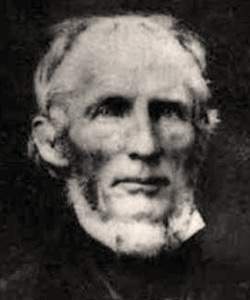Richard Armstrong (Dickinson Chronicles)
Scholarship
Richard Armstrong was born in Turbotville, Northumberland County, Pennsylvania on April 13, 1805. He entered Dickinson College with the class of 1827 and upon graduation entered the Princeton Theological Seminary. He was ordained by the Baltimore Presbytery on October 7, 1831 and a month later sailed from New Bedford, Massachusetts on a mission to the Pacific Islands. Armstrong helped make up the "fourth reinforcement" of the Presbyterian mission to the Hawaiian Islands, arriving in May 1832. He first took charge of the mission at Nukahiva in the northern islands of the Marquesas group, known then as the Washington Islands. From there he went to the mission at Wailuku, Maui in July 1834 and served there until 1840. He returned to Honolulu on Oahu to take up the leadership of the First Church in November 1840 upon the return of Hiram Bingham, first leader of the mission, to the United States.
The Protestant mission developed a close relationship with the royal family of the islands, and in December 1847 Armstrong was named to the king's cabinet as minister of instruction and president of the board of education. He was also appointed to a seat in the House of Nobles, and to a membership in the Privy Council under Kamehameha III. His own mission approved of these steps and also transferred its Lahainaluna Seminary to the government. By 1858 the government was able to boast of 285 free schools with almost 10,000 pupils all over the islands. Armstrong was also responsible for opening the first library in the islands, the Honolulu Athenaeum, in 1851.
Armstrong's work was not without controversy. He had been in charge of the initial vaccination program which by February 1853 seemed to have halted a smallpox epidemic effecting the islands. However, a new outbreak struck later in the year, killing more than 3000 native inhabitants and bringing chaos to Honolulu. Factions hostile to a strong Hawaiian government took the opportunity to accuse Armstrong and another powerful cabinet member Gerrit Judd of negligence. Petitions were gathered for their removal, but the king forestalled any political problems by asking for the resignation of his entire council. He then promptly reappointed all but Judd.
Armstrong married Clarissa Chapman of Bridgeport, Connecticut in September 1831, eight weeks before their embarkation on the mission. They had ten children, most notably Samuel Chapman Armstrong, who completed his education at Williams College and later founded the Hampden Institute. In September 1860, Richard Armstrong was thrown from his horse and died of his injuries. His loss was widely mourned and King Liholiho himself authored the obituary for the Honolulu native papers.
The Protestant mission developed a close relationship with the royal family of the islands, and in December 1847 Armstrong was named to the king's cabinet as minister of instruction and president of the board of education. He was also appointed to a seat in the House of Nobles, and to a membership in the Privy Council under Kamehameha III. His own mission approved of these steps and also transferred its Lahainaluna Seminary to the government. By 1858 the government was able to boast of 285 free schools with almost 10,000 pupils all over the islands. Armstrong was also responsible for opening the first library in the islands, the Honolulu Athenaeum, in 1851.
Armstrong's work was not without controversy. He had been in charge of the initial vaccination program which by February 1853 seemed to have halted a smallpox epidemic effecting the islands. However, a new outbreak struck later in the year, killing more than 3000 native inhabitants and bringing chaos to Honolulu. Factions hostile to a strong Hawaiian government took the opportunity to accuse Armstrong and another powerful cabinet member Gerrit Judd of negligence. Petitions were gathered for their removal, but the king forestalled any political problems by asking for the resignation of his entire council. He then promptly reappointed all but Judd.
Armstrong married Clarissa Chapman of Bridgeport, Connecticut in September 1831, eight weeks before their embarkation on the mission. They had ten children, most notably Samuel Chapman Armstrong, who completed his education at Williams College and later founded the Hampden Institute. In September 1860, Richard Armstrong was thrown from his horse and died of his injuries. His loss was widely mourned and King Liholiho himself authored the obituary for the Honolulu native papers.
John Osborne and James W. Gerencser, eds., “Richard Armstrong,” Dickinson Chronicles, http://chronicles.dickinson.edu/encyclo/a/ed_armstrongR.htm.



